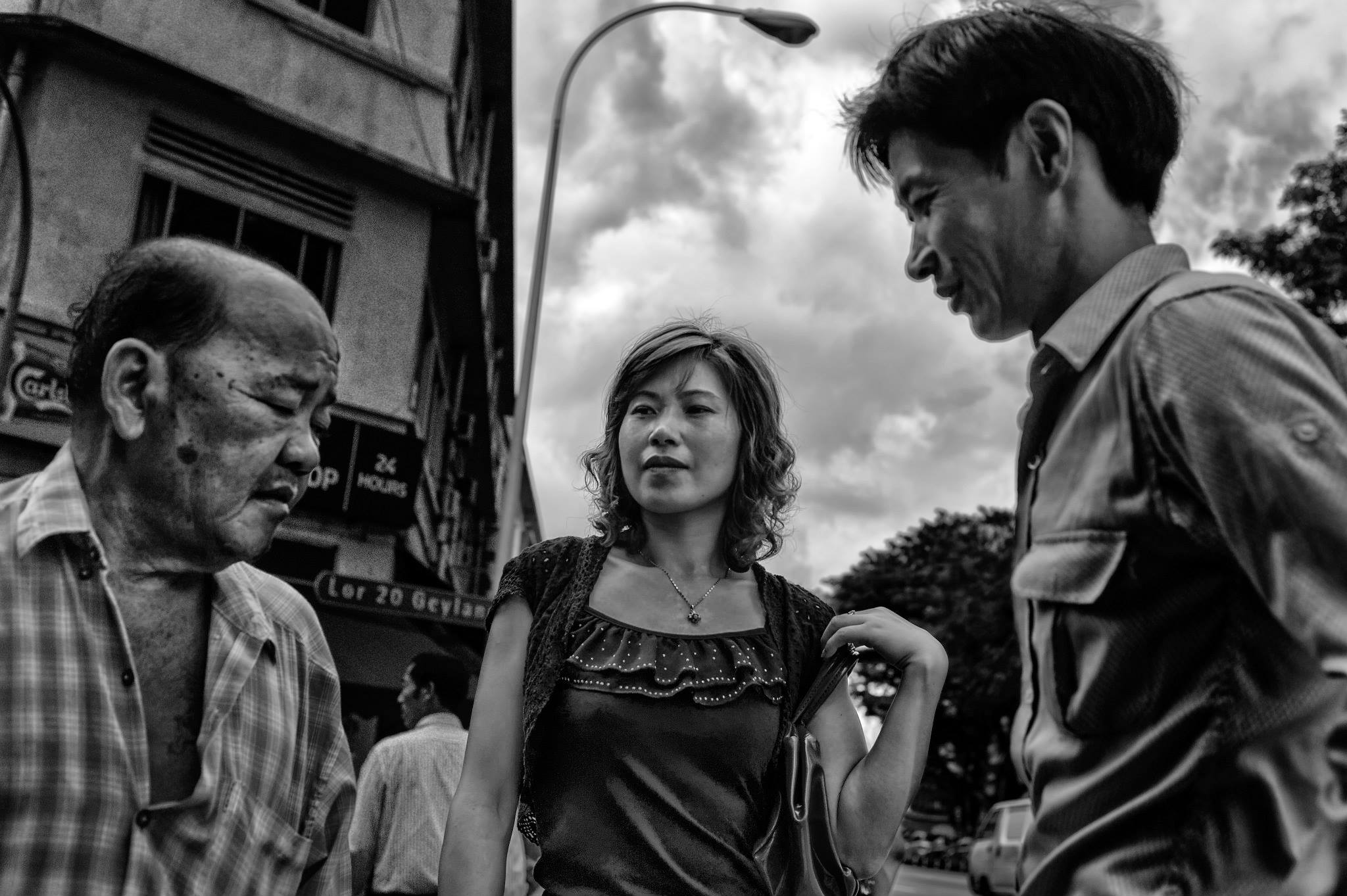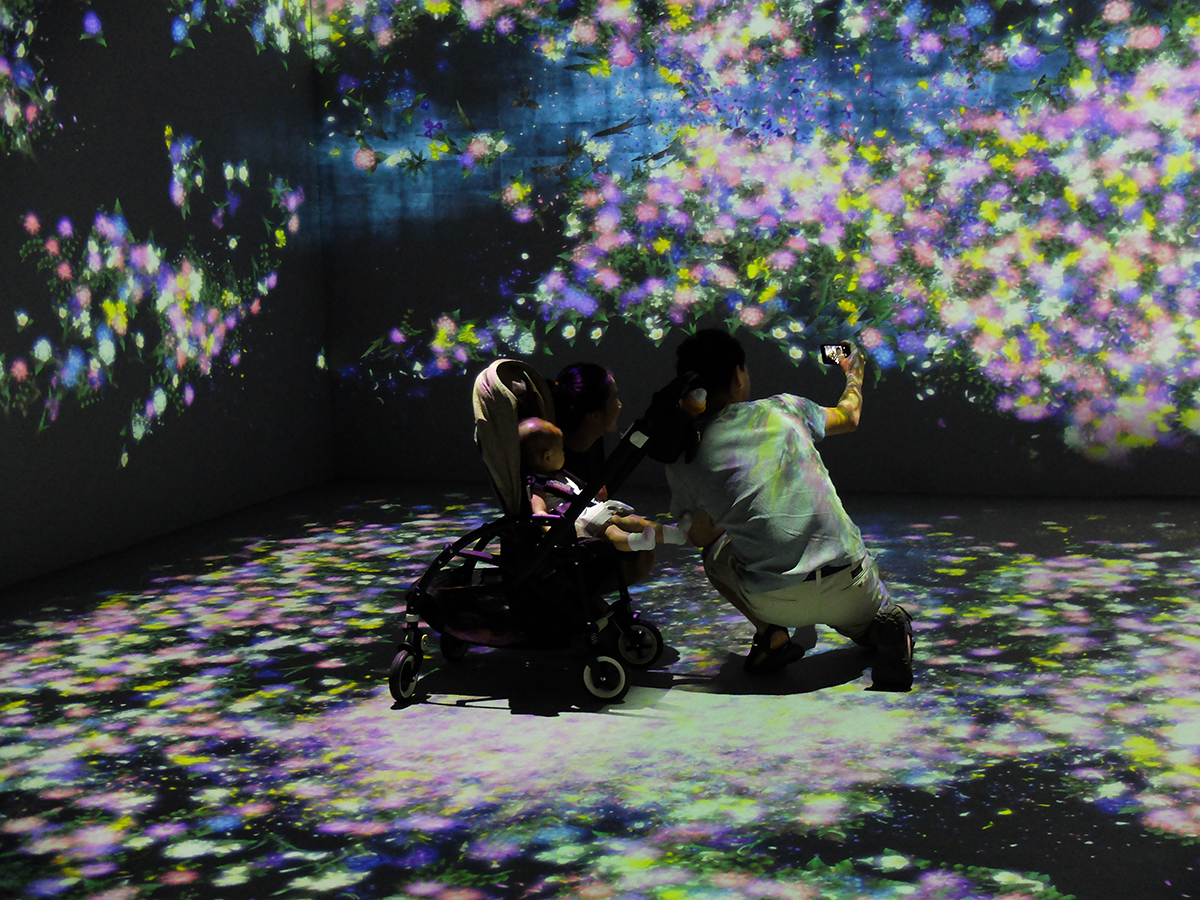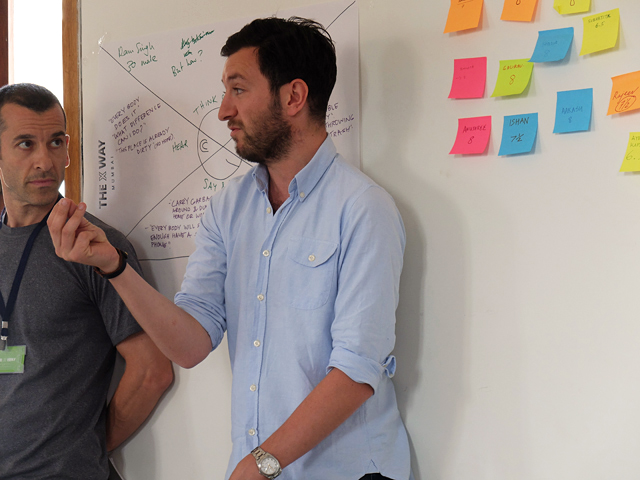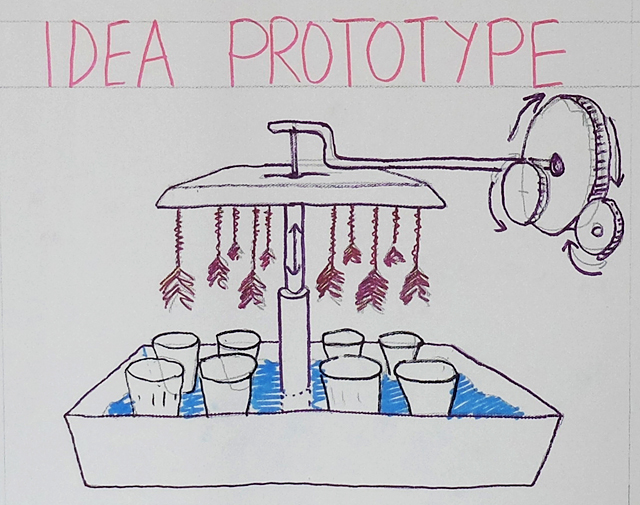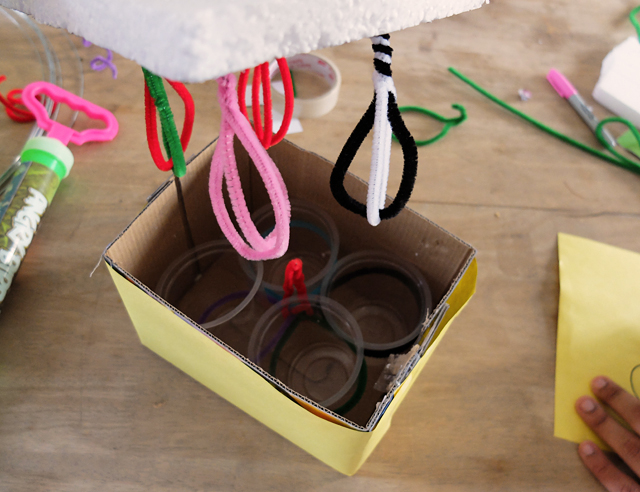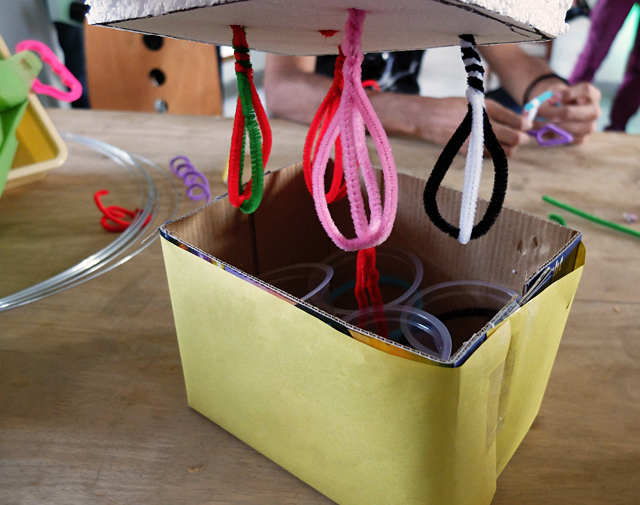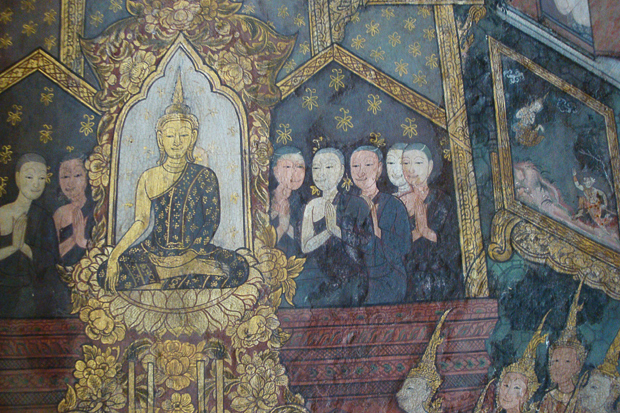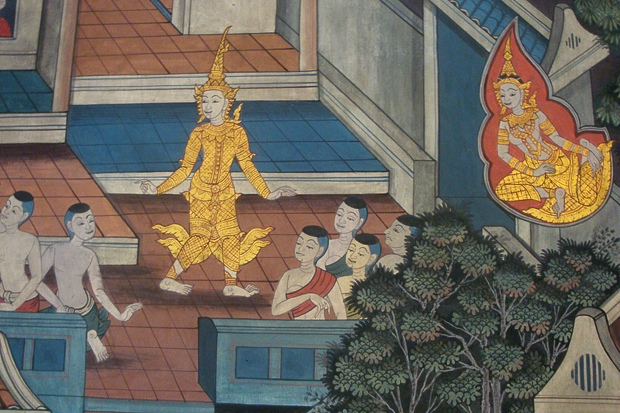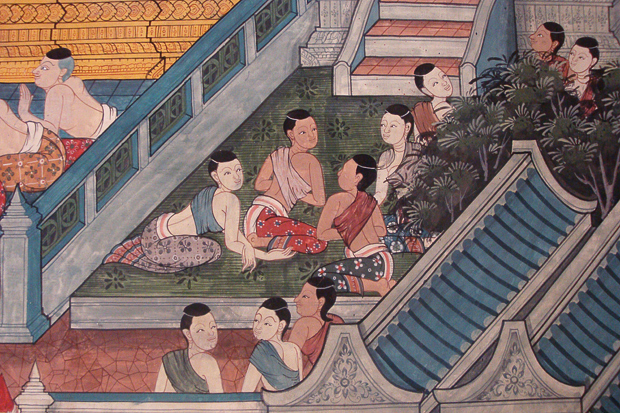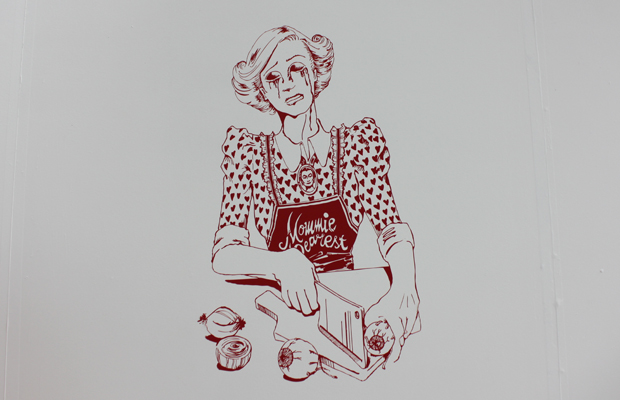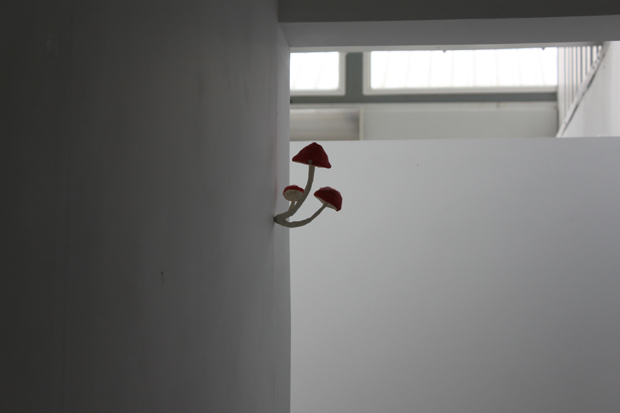Luciano Checco
Fascinating photographs by Luciano Checco of the 'other' side of Singapore.
Fascinating street photographs by Luciano Checco of the 'other' side of Singapore. Check out the entire album here.
Flowers & People
A young family enjoys the digital installation 'Flowers and People cannot be controlled but Live Together' by teamLab, a group of Japanese artists.
A young family enjoys the immersive digital installation 'Flowers and People cannot be controlled but Live Together.' It was part of the 'Art in Motion' series during Singapore art week. I noticed more than 8 massive projectors used to create the space. The flowers and petals grow, wither and die. As you move, the petals try to grow around you along with a tinkling almost fairy-like sound. Overall a beautiful, almost meditative experience.
Creating the Jugaad Dishwasher, The X-Way
The X-Way was a 2 day workshop sponsored by Nokia and Microsoft that focused on ideas, strategies and discussion around improving Mumbai city. Ben & Andrew moderated the workshop, keeping it challenging as twenty creatives and innovators came together with many, many city ideas.
The X-Way was a 2 day workshop sponsored by Nokia and Microsoft that focused on ideas, strategies and discussion around improving Mumbai city. Ben & Andrew moderated the workshop, keeping it challenging as twenty creatives and innovators came together with many, many city ideas.
One of the interesting exercises was listing things we love and hate about Mumbai. It was heartening to see that the 'love' pile was so much bigger despite Mumbai's numerous faults.
When discussing Mumbai's numerous problems, traffic cannot be ignored. Everything to do with traffic and way-finding is contextual. Signage is missing in a lot of places. When pedestrians give directions, the meaning may be different depending on the tone of their voice, how they stand, hand gestures and language. Honking has varied meanings depending on frequency, tones, loudness and the length of each honk. The city is a hotbed of large scale issues and topics of interest.
My team eventually looked at pavement ownership as a microcosm of health and sanitation. How could we encourage and create value in a public space such as pavement. We were in posh areas of Mumbai, and even here we found street hawkers taking ownership of pavements (in a good way) keeping them clean and ensuring their part of the pavement was maintained. Eventually we focussed even further and came up to a sugarcane vendor. Could we come up with something to help him wash the glasses in his stall while he was busy doing a million other things like making the juice, serving and cashing. A lot of times hygiene and proper washing was way down in his priorities while multi-tasking.
The final concept after two days of guerrilla research and quick prototyping was the 'jugaad dishwasher' - a mechanically automated machine that washed glasses saving the vendor time and effort as he ran a one-man operation. The washer connects to the juice machine itself so it doesn't need electricity to run. Soap is optional here since most vendors do not use soap. Overall the 'jugaad dishwasher' concept could also work for other street hawkers, juice vendors and with a few upgrades could even save time in someone's kitchen.
Check out some photos of the prototype we made. The video below has a few shots of us talking to sugarcane vendors.
The rotating juicer translates into the up and down movement of the simple washer, which repeatedly rinses the glasses. The trough can be easily refilled and cleaned and occupies minimal space.
Arduino Yun Workshop
The two day workshop by Ankit Daftery was a great way to dig deep into the possibilities of the Yun. As an interactive artist, I'm already aware of various options available. Trying them out was empowering and surprising. You can make complex interactions with just two to three days of effort [as a beginner], especially at an affordable price.
The two day workshop by Ankit Daftery was a great way to dig deep into the possibilities of the Yun. As an interactive artist, I'm already aware of various options available. Trying them out was empowering and surprising. You can make complex interactions with just two to three days of effort [as a beginner], especially at an affordable price.
This example converts two fruits into a drum kit, sort of a very basic version of the famous Makey Makey. Below is a short video of the test.
Installation Sketches
Worked on some collaborative concepts with Ankit Shekhawat who is the head of the Emerging Media lab at Moonraft in Bangalore. We pitched these ideas to an upcoming event in Bangalore. Conceptualizing these installations is a really fun process, especially when budget is not a constraint. Quite proud of these ideas, since we went crazy dreaming up robot drones to do our bidding.
Worked on some collaborative concepts with Ankit Shekhawat who is the head of the Emerging Media lab at Moonraft in Bangalore. We pitched these ideas to an upcoming event in Bangalore. Conceptualizing these installations is a really fun process, especially when budget is not a constraint. Quite proud of these sketches, since we went crazy dreaming up robot drones to do our bidding.
Hoping to get a chance [funding] to build this stuff one day.
Vikhroli Skin - Prep
My most recent work will be displayed at this event sponsored by Godrej Labs on the 14th of Dec. It is going to be 200 thousand square feet of art, performances and culture, so don't miss out if you are in Mumbai.
My most recent work will be displayed at this event sponsored by Godrej Labs on the 14th of Dec. It is going to be 200 thousand square feet of art, performances and culture, so don't miss out if you are in Mumbai. The space is an abandoned Godrej factory which will be demolished soon after the art event. The factory will be moved elsewhere. It is deeply relevant to the story of Mumbai and how it has grown into post-industrialization. Here are some images of the space, once the setup starts I will do my best to share photographs of the buildup.
The plan is create an interactive installation using projections, the audience and city images. It is going to be a real challenge setting up an installation outdoors, in the day time, where electricity is coming in from generators. Limited electricity means that planning and testing the installation in another location is crucial.
The Clock
Almost calming, at times ironic and humorous this 24 hour video work pulls you in and makes you just sit and watch for a while. I managed to watch it for 30 mins the first time and 2 hrs the second time. Almost addictive and hypnotic it's amazing how accurate the film is and lovely to spot familiar scenes from favorite movies or old classics I was forced to watch in art school.
While first entering this work by Christian Marclay, I was a bit sceptical due to the expensive MoMA entry fee of $18 and then the huge 45 minute queue to watch the video. Eventually I got in and it was worth the effort. Almost calming, at times ironic and humorous this 24 hour video work pulls you in and makes you just sit and watch for a while. I managed to watch it for 30 mins the first time and 2 hrs the second time. Almost addictive and hypnotic it's amazing how accurate the film is and lovely to spot familiar scenes from favorite movies or old classics I was forced to watch in art school.
A must-watch for anyone interested in the video art side of things. Ever since I accepted the fact that I cannot enjoy art at a purely intellectual level it is much easier for me to spot things that I like versus things I don't like. It's almost crude to divide art into these groups but it is true. You either feel something when you look at a work or you just don't feel it. You can still enjoy the techniques/concept/history/context/etc. that the artist uses but eventually it doesn't matter. If you really want to become an art lover, then be honest and admit that the giant 100 yr old oil painting of a naked woman is pretty cool but doesn't do anything for you.
The Clock 2010 by Christian Marclay. Single-channel video with stereo sound. Twenty-four hours. Image Source.
Ramkinkar Baij
However it was enlightening to see his growth as a brilliant artist and the extent to which his personal philosophies, politics and ideas were so deeply and honestly entrenched in his work and life. Baij clearly 'lived' his ideals, spending a lot of time with the Santhals who were a prominent topic within his work.
I recently visited NGMA, where they had an exhaustive collection of this artist's work. At first I was skeptical about what was clearly a collection of work from a long ago era of Indian art. Personally, I favor viewing more radical or contemporary works. However it was enlightening to see his growth as a brilliant artist and the extent to which his personal philosophies, politics and ideas were so deeply and honestly entrenched in his work and life. Baij clearly 'lived' his ideals, spending a lot of time with the Santhals who were a prominent topic within his work. His abstract sculptures were a pleasure and my favorites amongst his life's work. His sculptures of animals were brilliant and at times even humorous.
Dog by Ramkinkar Baij, Terracotta, 1950's. 38.5 by 29.5 by 22cm. Image Source: Delhi Art Gallery.
The Poet by Ramkinkar Baij. 1938. Image Source.
Other works worth noting are The Harvest 1957 (oil on canvas), Atomika 1969 (oil on canvas), and a sculpture portrait of Pramod Ganguly (Plaster of Paris).
Gallery Reflexive
Work by Prajakta Palav. It caught my eye because of the way she had used the gallery floor in her work. It is intelligent and relevant, especially in these old buildings in South Mumbai that are converted into gallery spaces.
Prajakta Palav (Dec, 2011). This caught my eye because of the way she has used the gallery floor in her work. It is intelligent and relevant, especially in these old buildings of South Mumbai that are converted into gallery spaces. What I love about this is how the work is almost indistinguishable from the gallery floor at first glance. It makes you sit up and pay attention. Here are some pictures I managed to take from my mobile phone.
Reclining Buddha Murals
These are photographs of the detailed murals that decorate the walls and windows of the Reclining Buddha temple. It exists in a much larger temple complex called the Wat Pho, which contains several hundred images of Buddha, many stupas, a huge Bodhi tree, stone statues and smaller temples.
These are photographs of the detailed murals that decorate the walls and windows of the Reclining Buddha temple. It exists in a much larger temple complex called the Wat Pho, which contains several hundred images of Buddha, many stupas, a huge Bodhi tree, stone statues and smaller temples. The scenes narrate the story of Buddha, and remind me of the vast murals in the Ajanta caves which are much older.
From the photos you notice that some parts of these murals look newer than others. I can only guess that these parts have been restored and touched up recently.
Neon Workshop
The neon workshop was a one-day crash course on making neon lights. Detailed demonstrations on how to bend glass tubes, suck out all the air and then fill the tube with either neon, argon or helium took up the first half of the day. The second half was spent exploring the material, after which we were given free reign on the propane blowtorches!! :)
Cutting a glass tube
Glass tubes are bent after careful heating in the right angles, using gravity. Results like this only come after lots of practice.
The ribbon burner has a long flame that softens a large part of the tube evenly.
Joining two glass tubes using a precise burner was extremely difficult. I totally failed at my attempt, I ended up blowing a glass bubble instead because of too much air, and then the bubble burst. A tube with a hole can never be used for neon.
Part of the giant machine that creates a vaccum in the tubes before filling it with the required gases.
Neon master Julia Bickerstaff and British artist Richard Wheater encouraged us to question the limits of the material and explore its potential in relation to our individual art practice. That was the best part, being introduced to a completely new medium and told to freak out with it on the same day. Also worth mentioning was how to transcribe an idea into a drawing for neon-making.
The video below is my work (made by Julia of course) which we filled with helium. I love the colour of helium, its a natural pink hue that went well with the concept, which is the number sixty-nine in Devanagari letterforms. Due to a few impurities added in the tube flickers continuously, an effect that I really really wanted to try out. Another way to do this would be to programme it to flicker. However this is purely physical and does not need any external controls.
The best work was displayed later at the Light Night festival in Bournemouth town center and the Neon: Shaping Light exhibition at the text+work gallery.
Shift Exhibition
Have a look at our post-graduate show Shift. This friday (9th September) is the last day so don't miss it if you're in or around Bournemouth :)
Artist Yi Lu with her paper mache world
Subconscious Form by Shiro Araki
Urban Brick by Bana Toutounjee
by Taro Morimoto
Mumbai/Bombay by Aditi Kulkarni
New Blindness by Rocco Nahas
A stretchable movie by Richard Hurst.
Be-Bee Project by Kaya J. Lee
The Ophelia Project by Samantha Else.
Out of Sight
With an unused underground car park as its gallery walls, Out of Sight investigates the resilience and flexibility of art, and the need for its development with supporting communities in unorthodox circumstances: an appreciation for the otherwise overlooked in the chosen location compliments the political provocation of the role of the outsider in society and rebellion against industry precepts.
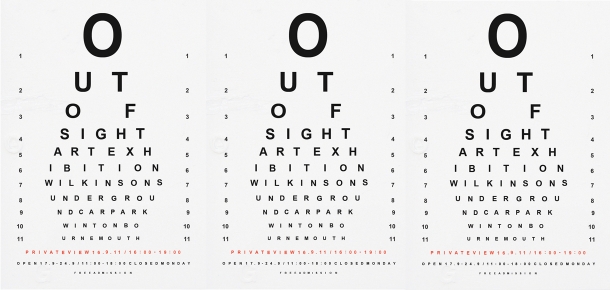 The exhibition Out of Sight is from 17th to 24th of September from 11am to 6pm and will showcase a wide variety of artwork from multimedia installations to sculpture and drawing.
The exhibition Out of Sight is from 17th to 24th of September from 11am to 6pm and will showcase a wide variety of artwork from multimedia installations to sculpture and drawing.
With an unused underground car park as its gallery walls, Out of Sight investigates the resilience and flexibility of art, and the need for its development with supporting communities in unorthodox circumstances: an appreciation for the otherwise overlooked in the chosen location compliments the political provocation of the role of the outsider in society and rebellion against industry precepts.
Below is a video by Michael Compton of day two of the massive clean-up of the dark, unused space.
More on Shadows
In his essay In Praise of Shadows Japanese novelist Tanizaki writes about the conflict between western and eastern aesthetics in the modern world. He says that Japanese 'find beauty not in the thing itself but in the patterns of shadows, the light and the darkness, that one thing against another creates.' He emphasizes beauty in subtlety and that which cannot be seen too clearly, leaving some of the experience to our imagination. Pallasmaa talks of something similar when he emphasizes the importance and intimacy of darkness.
In his essay In Praise of Shadows Japanese novelist Tanizaki writes about the conflict between western and eastern aesthetics in the modern world. He says that Japanese 'find beauty not in the thing itself but in the patterns of shadows, the light and the darkness, that one thing against another creates.' He emphasizes beauty in subtlety and that which cannot be seen too clearly, leaving some of the experience to our imagination. Pallasmaa talks of something similar when he emphasizes the importance and intimacy of darkness:
The eye is the organ of distance and separation, whereas touch is the sense of nearness, intimacy and affection. The eye surveys, controls and investigates, whereas touch approaches and caresses. During overpowering emotional experiences, we tend to close off the distancing sense of vision; we close our eyes when dreaming, listening to music, or caressing our beloved ones. Deep shadows and darkness are essential, because they dim the sharpness of vision, make depth and distance ambiguous, and invite unconscious peripheral vision and tactile fantasy. (Pallasmaa, 1996, p.46).
Pallasmaa continues to say that bright lights kill our imagination whereas twilight, dimly lit spaces and foggy scenes spark our sense of mystery, the mystical and mythological. Tanizaki also mentions this sense of tranquility and calm in shadows, that which separates the inside from the outside:
Whenever I see the alcove of a tastefully built Japanese room, I marvel at our comprehension of the secrets of shadows, our sensitive use of shadow and light. For the beauty of the alcove is not the work of some clever device. An empty space is marked off with plain wood and plain walls, so that the light drawn into its forms dim shadows within emptiness. There is nothing more. And yet, when we gaze into the darkness that gathers behind the crossbeam, around the flower vase, beneath the shelves, though we know perfectly well it is mere shadow, we are overcome with the feeling that in this small corner of the atmosphere there reigns complete and utter silence; that here in the darkness immutable tranquility holds sway. (Tanizaki, 1977).
In my work there is a combination of bright light that hurts the eye and multiple shadows. Parts of the space are brighter and dimmer than others. The views of the city begin with twilight, continue to sunset and then cycle back to twilight in an endless loop. Various kind of shadows are present in the work, those that are glaring and sharp and others that are subtle and noticeable only after an amount of time spent in the space. Due to a feedback loop dim mirror versions of yourself are also visible in the walls, each a mere second after the next. The overall effect is an experience which is disconcerting as you see several shadows of yourself, the other in the walls on either side. Despite bright lights the audience cannot see the entire work because the city is fragmented with shadows. The gaps and shadows leave the final interpretation up to the audience themselves. It is an experience which aims to express the inner conflict of the city, which I call Mumbai.
Reference: Pallasmaa, J. (1996). Eyes of the Skin: Architecture and the Senses. John Wiley & Sons: UK. Sowin, J. (2006). In Praise of Shadows: A Meditation. [online]. Available from:http://www.fireandknowledge.org/archives/2006/09/23/in-praise-of-shadows-a-meditation/ [Accessed 17th August 2011]. Tanizaki, J. (1977). In Praise of Shadows. Leete's Island Books: USA
Nico Vascellari
The artist and musician creates sound and light installations that center around themes of nature, spaces, and spiritualism. His work at the Biennale interested me because of his use of shadow, especially the way the audience's shadows are incorporated into projected slides of his collage work. The experience is amplified by a loud sound every time the slide physically changes since an old world projector is used.
Nico Vascellari. Untitled Horizons, 2011. Collage on Paper 120 slides, three slide projectors. Dimensions variable. Courtesy of Bugada & Cargnel, Paris. Photo by Aditi Kulkarni, Venice.
Reference: Bugada and Cargnel. 2011. Nico Vascellari. [online]. Available from: http://www.bugadacargnel.com/en/pages/artistes.php?name=21891. Accessed 21st June 2011.
Dayanita Singh
I am especially interested in her attempts to express her own visions of a place or city, opposing the singular story people usually expect about India, that of 'sensational catastrophes and human failures'
Phil mentioned Singh in connection to my work on Mumbai because of her series of photographs titled Dream Villa. Her landscape images of Mumbai resonate with the kind of video I'm using for my installation. I am especially interested in her attempts to express her own visions of a place or city, opposing the singular story people usually expect about India, that of 'sensational catastrophes and human failures' (Cotter, H. 2005). Dream Villa 11. 2008. Dayanita Singh [Image Source]
House of Love 2010. Dayanita Singh. [Image Source].
Reference: Cotter, H. 2005. Objects of Repose and Remembrance. New York Times. [online]. Available from: http://www.nytimes.com/2005/03/30/arts/design/30cott.html?ex=1172638800&en=840b508f152bce9e&ei=5070 Date Accessed: 21st July 2011.
Degen, N. 2008. Dayanita Singh. Frieze Magazine. [online]. Available from: http://www.frieze.com/shows/review/dayanita_singh/. Accessed: 21st July 2011.
Dayanita Singh: House of Love. La Lettre. [online]. Available from: http://lalettredelaphotographie.com/entries/dayanita-singh-house-of-love. Date Accessed: 7th August 2011.
Danger of a Single Story
This brilliant TED video by novelist Chimamanda Adichie articulates what I often have to say about Mumbai while here in UK. Namely, yes there is poverty and yes we have slums - but these are proud people who are more than just the anonymous poor.
This brilliant TED video by novelist Chimamanda Adichie articulates what I often have to say about Mumbai while here in UK. Namely, yes there is poverty and yes we have slums - but these are proud people who are more than just the anonymous poor. They don't want your useless pity. When I make art about Mumbai I often have to defend my work and my position to outsiders because it is not the typical vision of what people imagine Mumbai to be, which is terrible disparity and nothing else. She is also quick to point out however, that all of us have at one point or the other indulged in a 'single story.' Whats important is to be aware of it and avoid it as much as possible.
Collaboration: The Third Hand
Through collaboration the singular voice of the artist is muted or dispersed, it is a break away from a singular artistic identity. The author introduces the idea of a 'third hand,' or ghost artist which is an elusive other or combined identity created in collaborative works. This third independent existence is in itself 'uncanny' because such a constructed ghost identity 'blurs the distinction between the real and phantasmic.'
[A summary of ideas from the book The Third Hand - Collaboration in Art from Conceptualism to Postmodernism].
The book focusses on a period of western art history during the 1960's and 1970's which the author identifies as the beginnings of artist collaboration, a conscious movement away from individual lone artists making work in a conventional studio. He describes and classifies three kinds of collaborative artist teams. What most interested me in the discussion of the meanings and motivations behind various types of collaboration, was the issue of identity.
Through collaboration the voice of the artist is muted or dispersed, it is a break away from a singular artistic identity. The author introduces the idea of a 'third hand,' or ghost artist which is an elusive other or combined identity created in collaborative works. This third independent existence is in itself 'uncanny' because such a constructed ghost identity 'blurs the distinction between the real and phantasmic.'
The author's discussion of the uncanny helped me better understand my previous collaborative project Tobari No Akari 2. Using dolls, dream-like doubles and shadow doubles the images we created are surreal and uncomfortable, bringing forth memories from childhood but in a disconcerting way. We could also say that creating ghost doubles in the installation references the joint artistic will of the collaboration and work itself.
The video shown below is an attempt to document the collaborative process where we arranged and re-arranged the installation over several hours. It highlights the importance of collaboration as a method of creating more avenues of future work; as well as the potential for it to be a work of art in terms of performance.
The author also talks about artists that use collaboration as a means to escape personal limits and language, to travel beyond conventional authorship and representations of identity, or a 'relativisation and reformation of self.' I felt this was especially relevant to the motivation behind my collaborative projects; however I hesitate to deconstruct or over-explain the experience for fear of losing sense of its meaning and to some extent, its mystery.
Shift
Shift the post-graduate show will be held at the Arts University College Bournemouth from 2nd to 9th September, open from 10am to 4:30pm daily. Entry is free. The show will be open for a late night viewing on the 8th (Thursday) and is closed on Sunday.
 Shift the post-graduate show will be held at the Arts University College Bournemouth from 2nd to 9th September, open from 10am to 4:30pm daily. Entry is free. The show will be open for a late night viewing on the 8th (Thursday) and is closed on Sunday. The Facebook page is here.
Shift the post-graduate show will be held at the Arts University College Bournemouth from 2nd to 9th September, open from 10am to 4:30pm daily. Entry is free. The show will be open for a late night viewing on the 8th (Thursday) and is closed on Sunday. The Facebook page is here.
Don't miss it! The exhibition will showcase the work of post-graduate students in Animation, Contemporary Performance, Graphic Design, Interactive Media, Costume, Fashion, Fine Arts and Photography. The work will reflect the multidisciplinary nature of the post-graduate course here at AUCB, and each student's individual pathway.
Stay tuned for more updates on the show. And if you can't make it don't fret, I will be posting photos and videos of the awesome event :)
Update: Photos and videos here.
Site-Specific Art
In his book Eyes of the Skin, Pallasmaa talks at great length about the beauty of human perception and how the senses interact with each other to form experience. He emphasizes the importance of a sense experience as a whole. He says there is a bias to the eye in the architectural practice because people are focussed on how a building looks rather than how a body can move within it or how it feels. When it comes to the perception of places he discusses the importance of emotion, memory, imagination and fantasy.
During my research into place-making in phase two I briefly discussed the rigidity of a panoramic city view and my attempts to break it by framing unfamiliar cityscapes, using shadows and through collaboration. The book is relevant to my studies because it discusses creating place, the transitive nature of site, framing and virtual and 'real' spaces. The author describes monuments as loci's of power and authority (Kaye, 2000) in his chapter on Performing the City. This underlines the rigidity of the panorama since monuments are an iconic part of them. A relevant example is Mumbai's famous Nariman Point which is named after a historical Congress party leader and contains Indian and international financial institutions and government buildings such as CBI, RBI, Mittals, Birla's, JP Morgan, Merrill Lynch, Vidhan Sabha etc.
Monumentality […] always embodies and imposes a clearly intelligible message. It says what it wishes to say - yet it hides a good deal more: being political, military and ultimately fascist in character" (Lefebvre, 1991 cited in Kaye, 2000, p. 34).
He also discusses the relation between the body and the city or built environment and the body and the space, which in this case is the installation space in artist Wodiczko's work. A completely artificial and constructed installation is also a built environment. People interact with the architecture of the city, and similarly the audience interacts with the architecture of installation. The artist says that 'Our position in society is structured through bodily experience with architecture' (Wodiczko, 1992 cited in Kaye, 2000, p. 38).
In the installation test below, the audience directly affects an abstracted view of the city. In this constructed space people can directly change and affect an image of the architecture, making it fluid and interchangeable.
The author says 'where the site functions as a text perpetually in the process of being written and being read, then the site-specific work's very attempt to establish its place will be subject to the process of slippage, deferral and indeterminacy in which its signs are constituted' (Kaye, 2000, p. 183).
Further reading lead me to Merleau-Ponty's theories of phenomenology and perception where he discusses the essence of perception and experience. He says that we cannot separate our minds and bodies from our perception of the world, or in other words that we are 'condemned to meaning' (Merleau-Ponty, 1962, p. xxii). In his book the Phenomenology of Perception he discusses the relationship between reflective and unreflective experience, psychological and physiological aspects of perception, and consciousness as a process that includes feeling and reasoning.
We must not, therefore, wonder whether we really perceive a world, we must instead say: the world is what we perceive. (Merleau-Ponty, 1962, xviii).
In his book Eyes of the Skin, Pallasmaa talks at great length about the beauty of human perception and how the senses interact with each other to form experience. He emphasizes the importance of a sense experience as a whole. He says there is a bias to the eye in the architectural practice because people are focussed on how a building looks rather than how a body can move within it or how it feels. When it comes to the perception of places he discusses the importance of emotion, memory, imagination and fantasy:
We have an innate capacity for remembering and imagining places. Perception, memory and imagination are in constant interaction; the domain of presence fuses into images of memory and fantasy. We keep constructing an immense city of evocation and remembrance, and all the cities we have visited are precincts in this metropolis of the mind. (Pallasmaa, 2005, p.67).
In my attempts to create a feeling of conflict within the city, a subtle realization of the bipolarity within Mumbai, the result was a space that could not be expressed as a still image. Not could it be expressed by only video. By adding a third dimension of time and motion, where the audience themselves make the image change and break the city is read as something in constant flux.
I know myself only in my inherence in time and in the world, that is, I know myself only in ambiguity. (Merleau-Ponty, 1962, p.402).
Reference: Kaye, N. 2000. Site-Specific Art: Performance, Place and Documentation. Routledge: London Merleau-Ponty. 1962. Phenomenology of Perception. Routledge: London. Pallasmaa, J. (2005). Eyes of the Skin: Architecture and the Senses. John Wiley & Sons: UK. View Wodiczko's Bio & Work in detail.








